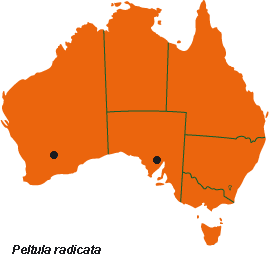



Australian Biological Resources Study
| Checklist of the Lichens of Australia and its Island Territories | ||
| Introduction | A–D | E–O | P–R | S–Z | Oceanic Islands | References | ||
| Peltula radicata Nyl. | ||
| Ann. Sci. Nat. Bot., sér. 3,20: 316 (1853). T: Biskra, Algeria, Balansa; lecto: H-NYL 30886, fide C.M.Wetmore, Bryologist 79: 308 (1976). | ||
| Thallus squamulose; squamules orbicular, 0.5–3 mm wide, 0.3–0.5 mm thick, plane to concave, yellow to yellowish olive (K+ red), anchored by a thick central rhizinose strand, and squamules connected by subterranean branches of the strand; surface dotted by minute concave punctae. Upper cortex poorly developed, paraplectenchymatous; epinecral layer 18–25 µm thick, yellowish. Medulla composed of densely interwoven and adglutinated hyphae; photobiont layer 50–80 µm thick. Lower cortex paraplectenchymatous, 20–50 µm thick, composed of hyphae with globose cells. Apothecia very rare, immersed, 1 per squamule; disc open, red to brown; hymenium wine-red or blue in iodine. Ascospores 16–64 per ascus, globose, 5–7 µm diam. Pycnidia not known. |  |
|
| Occurs on sandy soil in W.A. and on Carboniferous red aeolian sands in S.A. Also known from North Africa, Cape Verde Is., arid parts of North America, Mexico and Mongolia. | ||
| Büdel (2001) | ||
| Checklist Index |
| Introduction | A–D | E–O | P–R | S–Z | Oceanic Islands | References |
This work is copyright. Apart from any use as permitted under the Copyright Act 1968, no part may be reproduced by any process without prior written permission from Australian Biological Resources Study. Requests and inquiries concerning reproduction and rights should be addressed in the first instance to Dr P. McCarthy. These pages may not be displayed on, or downloaded to, any other server without the express permission of ABRS.